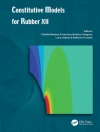This book comprehensively and systematically treats modern understanding of the Nano-Bio-Technology and its therapeutic applications. The contents range from the nanomedicine, imaging, targeted therapeutic applications, experimental results along with modelling approaches. It will provide the readers with fundamentals on computational and modelling aspects of advanced nano-materials and nano-technology specifically in the field of biomedicine, and also provide the readers with inspirations for new development of diagnostic imaging and targeted therapeutic applications.
Daftar Isi
1 Computational Approaches in Biomedical Nanoengineering: An Overview 1
Ayesha Sohail and Zhiwu Li
1.1 Introduction 1
1.2 Nanobiotechnology in Disease Diagnosis 3
1.2.1 Application of Nanoparticles for Discovery of Biomarkers 4
1.2.2 Nanotechnology-based Biochips and Microarrays 5
1.2.3 Detection via Semiconductor Nanocrystals 5
1.2.4 Nanoscale Sensor Technologies for Disease Detection via Volatolomics 6
1.3 Nanobiotechnology in Treatment 8
1.4 Nanobiotechnology in Target-specific Drug Delivery 8
1.4.1 Future of Giant Magnetoresistance (GMR) Sensors: An Alternative to the Traditional Use of Enzymes, Radioisotopes, or Fluorescent Tagging 8
1.4.2 Drug Delivery via Hyperthermia 9
1.5 Computational Approaches 10
1.5.1 Computational Model of Drug Targeting 11
1.5.2 Computational Model of Electrical Activity in Cardiac Tissue 11
1.5.3 Computational Model of Fringe Field Effect 13
1.5.4 Computational Model of Nanoparticle Hyperthermia 14
1.5.5 Hybrid Models in Computational Nanobiotechnology 15
1.5.6 Machine Learning for Detection and Diagnosis of Diseases 15
1.5.6.1 Machine Learning and Recent Bioinformatics: Case Studies 16
1.5.6.2 Current Challenges 17
References 18
2 Nanotechnology Applications – The Future Arrived Suddenly 23
Manuel Alberto M. Ferreira and José A. Filipe
2.1 Introduction 23
2.2 Nanotechnology: A Brief Approach 24
2.3 Nanopanels: A Success of Nanotechnology in Industry 28
2.4 Nanoelectronics: Improving the Life Standard 30
2.5 Nanotechnology in Medicine: Friendly Efficient Healthcare 32
2.6 Ethics and Nanotechnology 34
2.7 Concluding Remarks 39
References 40
3 Biosynthesized Nanobullets for Microbes and Biofilms 43
Lubna Sherin, Zareen Arshad, and Tehniyat Liaqat
3.1 Introduction 43
3.2 Biosynthesized Nanoparticles 44
3.2.1 Microorganisms 45
3.2.2 Algae 47
3.2.3 Fungi 48
3.2.4 Yeasts 50
3.2.5 Actinomycetes 51
3.2.6 Plants 52
3.3 Antimicrobial Potential of Nanoparticles 55
3.4 Mechanism of Antimicrobial Action of Inorganic NPs 57
3.4.1 Interaction of NPs with Cell Membrane 57
3.4.2 Oxidative Stress 58
3.4.3 NP Interaction with Proteins 59
3.5 Reactivity of NPs against Biofilms 59
3.6 Nanosilver as Efficient Antimicrobial Agent 63
3.7 NPs as Efficient Carrier of Traditional Antibiotics 65
3.8 Real-life Applications of Antimicrobial Nanomaterials 68
3.8.1 Wound Dressing Materials 68
3.8.2 Tissue Scaffolds 69
3.8.3 Disinfecting Medical Implant and Devices 70
3.8.4 Antimicrobial Food Packaging 70
3.8.5 Water Disinfection 72
3.8.6 Application in Personal Care Products 73
3.9 Conclusion and Future Prospects 73
References 74
4 The Physics of Nanosensor Systems in Medicine and the Development of Physiological Monitoring Equipment 89
Robert Splinter
4.1 Introduction 89
4.1.1 Biological Sensing 89
4.1.2 Applications 92
4.2 Sensing Technology 93
4.2.1 Sensing Targets 93
4.2.2 Static vs Dynamic Events/Sensing 93
4.2.3 Mechanism of Action (Mo A) for Sensing 94
4.2.3.1 Chemical 95
4.2.3.2 Electronic 95
4.2.3.3 Mechanical 98
4.2.3.4 Optical 100
4.2.3.5 Single-molecule Detection/Tagging Sensor Design 100
4.2.3.6 Thermal/Energetic 101
4.3 Sensor Design 102
4.3.1 Ion-sensitive Solid-state Field-Effect Transistor (ISFET)/Chem FET 102
4.3.2 Carbon Nanotube Field-Effect Transistor (CNTFET) 104
4.3.2.1 Computational Analysis of Nanosensor Detection 106
4.4 Discussion 107
References 108
5 Nonlinear Multiphysical Laminar Nanofluid Bioconvection Flows: Models and Computation 113
O. Anwar Bég
5.1 Introduction 113
5.1.1 Bioconvection 113
5.1.1.1 Bioconvection Lewis Number 115
5.1.1.2 Bioconvection Péclet Number 116
5.1.2 Nanofluids 116
5.1.2.1 Buongiorno MIT Model 117
5.1.2.2 Nanofluid Heat Capacity Ratio 118
5.1.2.3 Brownian Motion Parameter 118
5.1.2.4 Thermophoresis Parameter 119
5.1.2.5 Tiwari–Das Model 119
5.2 Numerical and Semi-numerical Methods 121
5.2.1 Overview of Numerical/Semi-numerical Methods 121
5.2.2 Finite Element Methods 122
5.2.3 Finite Difference Methods 123
5.2.3.1 Keller Box Method 123
5.2.3.2 Nakamura Tridiagonal Scheme 124
5.2.4 Adomian Decomposition Method 124
5.2.5 Gauss–Lobatto Quadrature 126
5.3 Multiphysical Nanofluid Bioconvection BVPs 126
5.3.1 Von Kármán Swirl Bioconvection Nanofluid Model 126
5.4 Conclusions/Future Directions in Nanofluid Bioconvection 140
References 140
6 Exploring Nanotechnology Applications in Medicine 147
Stefano Nobile and Lucio Nobile
6.1 Introduction 147
6.2 Nanotechnology in Medicine 148
6.2.1 The Nervous System 149
6.2.2 Cancer 154
6.2.3 Infectious Diseases 154
6.2.4 Cardiovascular Diseases 155
6.2.5 Pneumology 155
6.3 Bone Tissue Engineering 156
6.3.1 Components of the Skeletal System 156
6.3.2 Scaffolds 159
6.3.3 Bioactive Nanoparticles 162
6.3.4 Improvement of Scaffold Mechanical Strength 163
References 166
7 Microtubules: Nanobiomechanical Simulation 173
Mohsen Motamedi
7.1 Introduction 173
7.2 Microtubules 174
7.2.1 Assembly and Disassembly of Microtubules 175
7.3 Review on Previous Researches 176
7.3.1 Experimental Researches 176
7.3.2 Analytical and Computational Research 178
7.4 Microtubule Dynamic Instability 179
7.4.1 Nanobiomechanical Model 180
7.4.1.1 Molecular Dynamic Analysis 180
7.4.1.2 Molecular Structural Mechanics 181
7.4.2 Final Model 187
References 187
8 Simulation of Flowing Red Blood Cells with and without Nanoparticle Dispersion Using Particle-based Numerical Methods 191
Abdolrahman Dadvand
8.1 Introduction 191
8.2 Biomechanical Properties of RBCs 192
8.3 RBC Membrane Models 193
8.3.1 Shell-based Membrane Models 193
8.3.2 Spring-based Membrane Models 196
8.3.3 Spring- and Damper-based Membrane Model 197
8.4 Numerical Simulations of RBC Motions in Capillaries 199
8.4.1 Dissipative Particle Dynamics (DPD) Method 199
8.4.2 Smoothed Particle Hydrodynamics (SPH) Method 201
8.4.3 Lattice Boltzmann Method (LBM) 203
8.4.4 Immersed Boundary Method (IBM) 205
8.5 Application of Particle-based Methods to Simulate RBC Motion 205
8.5.1 Preliminary 205
8.5.2 Applications of DPD Method in RBC Simulations 206
8.5.2.1 Simulation of Single RBC Motion 206
8.5.2.2 Single RBC Motion in Tube Flow 207
8.5.2.3 Simulation of Two or Multiple RBC Motion 207
8.5.3 Applications of SPH Method in RBC Simulations 210
8.5.4 Applications of LBM Method in RBC Simulations 211
8.5.4.1 Simulation of Single RBC Motion 211
8.5.4.2 Simulation of Two or Multiple RBC Motion 211
8.5.4.3 Simulation of RBC Suspension Motion 212
8.6 Other Particle-based Methods 212
8.7 Nanoparticle Dispersion in RBC Suspension 213
8.8 Advantages and Disadvantages of Particle-based Methods 215
References 215
9 Impact of Nanofluid in Medical Treatment by Mathematical Modeling 227
Khadija Maqbool and Sidra Shaheen
9.1 Concept of Fluid Mechanics and Basic Laws 227
9.2 Nanofluid and Properties 228
9.3 Newtonian and Non-Newtonian Fluid 229
9.4 Non-Newtonian Fluid Flow Model for Blood 229
9.5 Drug Delivery System 230
9.6 Nanoparticles as Drug Carrier 231
9.7 Importance of Shape and Material Properties of Nanoparticles 231
9.7.1 Carbon-Based Nanoparticles 231
9.7.2 Metallic Nanoparticles 232
9.7.3 Ceramic Nanoparticles 232
9.7.4 Polymeric Nanoparticles 233
9.8 Concentration Properties of Magnetic Nanoparticles 233
9.9 Treatment by Incorporating Magnetic Source 233
9.10 Treatment by Heat Transfer 233
9.11 Boundary Layer Flow of Power Law Nanofluid 234
9.11.1 Solution of the Problem 236
9.11.2 Graphical Results 236
9.12 Casson Nanofluid over a Stretching Surface 237
9.12.1 Solution of the Problem 239
9.12.2 Results and Discussion 239
9.13 Third-grade Nanofluid Flow in a Channel 239
9.13.1 Solution of the Problem 242
9.13.2 Results and Discussion 243
9.14 Hydromagnetic, Irrotational, Laminar Flow of Non-Newtonian Nanofluid Through a Channel 243
9.14.1 Solution of the Problem 248
9.14.2 Results and Discussion 250
References 252
10 Physiological Modeling and Simulation of Fluid Flows 255
Najeeb A. Khan and Faqiha Sultan
10.1 Introduction 255
10.2 Physiological Modeling and Mathematical Formulation 258
10.3 Solution of the Governing Equations 263
10.4 Results and Discussion 264
10.5 Conclusion 273
References 275
Index 279
Tentang Penulis
Ayesha Sohail, Ph D, is an expert on nonlinear science, nanobiotechnology, and numerical analysis. She has successfully developed and implemented numerical tools to solve systems governing the nanotechnology problems.
Zhiwu Li is a full professor at Xidian University, China. He has been a visiting professor at the University of Toronto, Technion (Israel Institute of Technology), Martin-Luther University, Conservatoire National des Arts et Métiers (Cnam), Meliksah Universitesi, King Saudi University, and the University of Cagliari. His current research interests include Petri net theory and application, supervisory control of discrete event systems, workflow modeling and analysis, system reconfiguration, game theory, and data and process mining.












